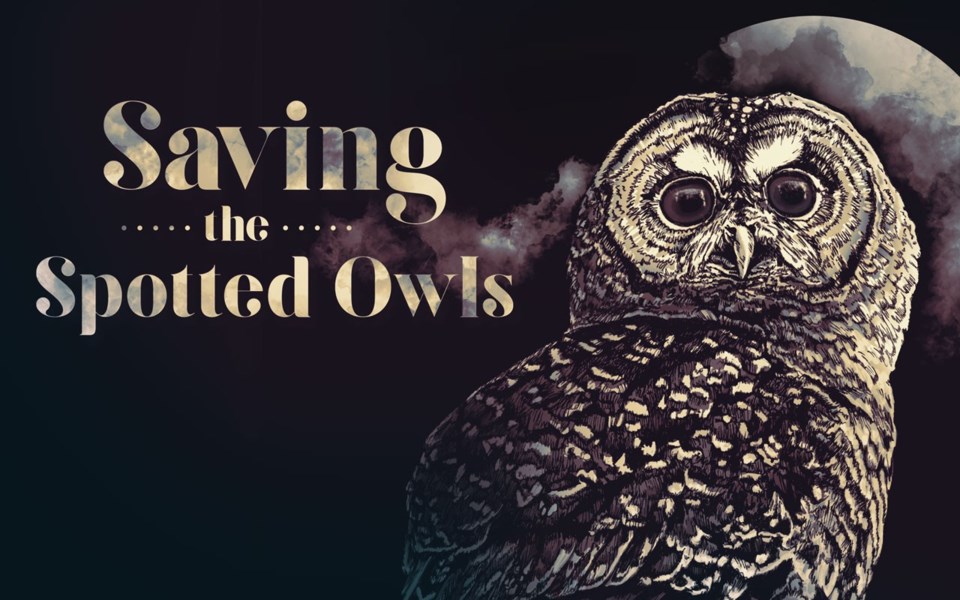
Three adorable little balls of fluff sit huddled together in a lab in Langley, the latest additions to a species struggling to survive. Chicks J, F, and G, hatched in late April and announced to the world this week, crazily represent at least 10 per cent of the total population of Northern Spotted Owls in British Columbia. One of their adopted "moms," biologist Jasmine McCulligh, fires me a quick email in between 20-plus hour shifts to announce their arrival. So far, according to McCulligh, these little fighters are doing just fine.
Things don't always go so smoothly. In the spring of 2017, McCulligh spent four days straight desperately trying to nurse a sick, newborn spotted owl back to health. "He was uncomfortable, thrashing around, burning calories and not eating, not settling. He just kept crying," she remembers, the frustration evident in her voice. "I couldn't say one hour to the next if he was going to survive." The tiny creature, called simply "chick D," was all skin and bone. He weighed less than a golfball, and refused to eat. Four times a day, McCulligh dropped three tiny pinpoints of diluted antibiotics into his mouth; he would grimace in disgust, but at least that meant the bitter medicine was making it into his mouth. The only thing that would comfort him was being held in McCulligh's palm. She lay on the cold, hard floor of the incubation room, cradling him in one hand, and texting the vet with the other, desperately waiting for any signs of improvement.
On the fourth day, chick D turned a corner. "He was so hungry," McCulligh remembers with a wide grin. The chick grew up, and the team changed his single-letter name to "Dante." "It means enduring. It was perfect for him, and also for the species," McCulligh says. Today, Dante is a feisty, healthy male owl, a prime candidate to sire his own kids and help expand his endangered species.
McCulligh's workplace is the world's one and only breeding centre for the Northern Spotted Owl (NSO), one of Canada's most endangered species. This bird's entire Canadian range sits within Southwestern British Columbia, where, it is thought, there used to be a healthy population of about 1,000 spotted owls between the Fraser Canyon, Lillooet, and Pemberton. (The Northern Spotted Owl's range extends south as far as Northern California, and the U.S. populations are officially considered threatened.) Depending on who you ask, there are thought to be between three and 10 spotted owls in the Canadian woods (yes, just three—that's not a typo), plus 23 living in this breeding centre, which serves as home to the Northern Spotted Owl Breeding Program.
The spotted owl's story is a sad one. In B.C., they live only in old-growth forests, where broken and rotted tree stumps make suitable, premade nesting spots. Their population began to crash in the 1980s as mature forests were logged, leading environmentalists to protest, which included embedding metal spikes within trees to destroy loggers' chainsaw blades. At the time, some in the logging industry developed a disdain for the owls, which stood in the way of their profits. In the U.S., the owls were granted federal protection in 1990, and logging was stemmed: timbre harvests on 9.7 million hectares of federal land dropped by 90 per cent. In Canada, they earned an official Species at Risk Act listing from the federal government in 1996; today, hundreds of thousands of hectares are being managed for the owls.
But the owls haven't bounced back.
Their new enemy, on top of habitat loss, is the barred owl: a larger bully of a species prone to "attacking anything that moves," says McCulligh, showing the scars on the backs of her hands left by barred owl attacks. The spotted owl is much pickier about its food, primarily eating pack rats and flying squirrels, so a spotted owl typically needs a hunting ground three to four times larger than its less-picky barred cousin.
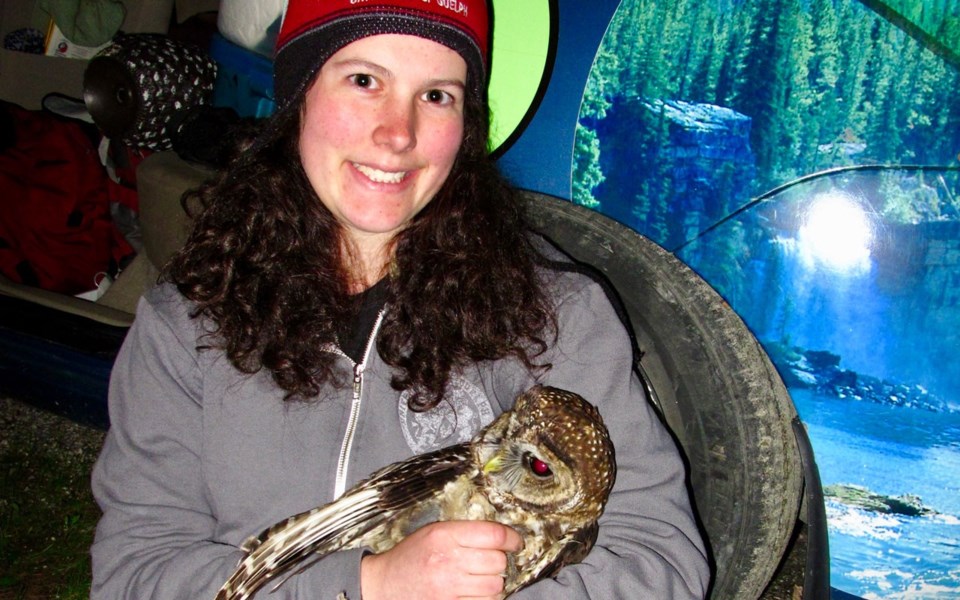
The features that make spotted owls so vulnerable in the wild also make up part of their charm. The owls are steady, reliable sorts—McCulligh says that, to her, they embody the serenity of the old-growth forest where they live. They pair up monogamously, usually for life. They will return to their nests year after year even if the surrounding forest is ravaged by fire or logging. Birders love to spot them, if they can: people notoriously mistake the more-common barred owls for spotted ones. For the record, spotted owls are smaller (the males are even smaller than the females). They have no ear tufts. As hinted by the name, they are more spotted than striped or barred. Every now and then, McCulligh gets a call from someone saying there's a spotted owl in their backyard, and they hold up the phone so she can hear the call: it's always the "Who cooks for you? Who cooks for you-all?" hoot of a barred owl, not the shorter, higher-pitched call of a spotted.
In the face of continued problems in the wild, scientists eventually decided to take drastic measures to save them. They gathered up the spotted owls that they could, including those that had been injured in the wild, or chicks that had fallen from their nests, and started a breeding program. The NSO Breeding Program officially opened in 2007 with just six birds. Today, the centre covers 10 ha. of farmland, with some 20 spread-out aviaries and a small incubation room. It's a tiny team, with just three full-time biologists: McCulligh, Katelyn West, and Hannah Tench. They have seen nine chicks successfully born thus far. If they get a stock of at least 10 breeding pairs (right now they have five), producing at least 10 chicks that survive a full year in the centre, McCulligh and her colleagues plan to start releasing 10 to 20 owls a year into the woods around Pemberton over the next 15 to 20 years.
The earliest that might start is 2020. And there are plenty of hurdles to overcome before then, including just working out their basic breeding biology. "I wish you could just Google how to breed a spotted owl, but you can't," sighs McCulligh. The very land the centre is on, which they lease with money from government grants, is currently for sale (for $10 million), so there's no guarantee they can even stay there. Eventually they will need better, larger aviaries that can hold flying squirrels, the owls' natural prey, so the birds can learn to hunt and fend for themselves. Then there's the question of whether there will even be enough suitable habitat left to release the owls into—a question that has left several environmental organizations fuming, saying that the province's funding has prioritized the breeding program over habitat recovery. It's altogether a hard task, and not guaranteed to work. But if they pull it off, they will save a species from local extinction. "I don't like to think about the pressure of it," says McCulligh. "It's a big deal."
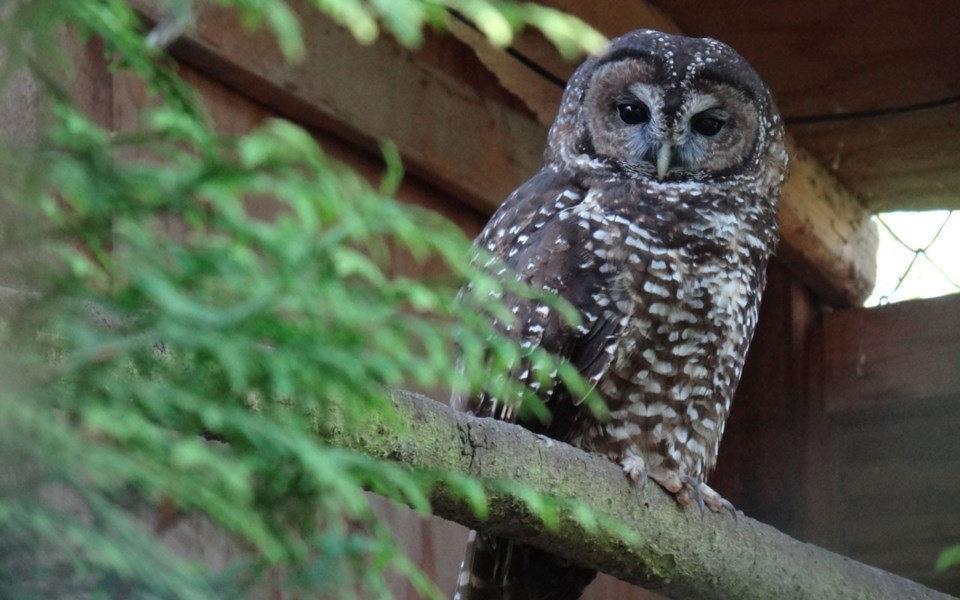
Back in the 1990s, Shakkai was hit by a car near Harrison Hot Springs and broke her wing. She spent more than a decade in a rehabilitation centre, and then was moved to the Langley breeding centre after it opened in 2007. At the age of 13, she was introduced to Einstein, a young, wild-caught owl who was just a year old. "They hit it off immediately. Even though she'd never seen a spotted owl in her life," McCulligh laughs. "When she saw him, she was so excited; she started calling immediately. She knew what to do." They had a baby—the centre's first—in 2008, a female named Shania. (Shania went on to have Dante, the sickly baby who fought for and won his life.)
The art and science of birthing baby spotted owls is something the team has had to muddle their way through. "It's incredible how different they are (from other owls)," says McCulligh. No one was sure what age they breed at, how many chicks they have per year, what makes for successful mating, and on and on. McCulligh and her small team have had to work it out themselves.
Generally speaking, this is how it works: First, the team plays matchmaker. They take into account the owls' age (the best pairs have an older female and a younger male), their genetics (biologists have completed genetic analysis of all their birds so they don't accidentally pair up relatives), and even their personalities, and then make introductions by letting a pair share an aviary. The male will usually start courting in February (an appropriately romantic month), by bringing his lady friend dead mice. "You have to buy her dinner first," laughs McCulligh. If she takes the food, it means she's accepting his advances. It can take months or even years for a newly-introduced pair to hit it off. "Last year, we had a pair where it took a month and she was just saying, 'No thanks, I'll go get my own food.' She could just be ignoring him even while he's shoving food in her face," McCulligh remembers. "Usually she'll eventually accept it; I guess at that point it's settling."
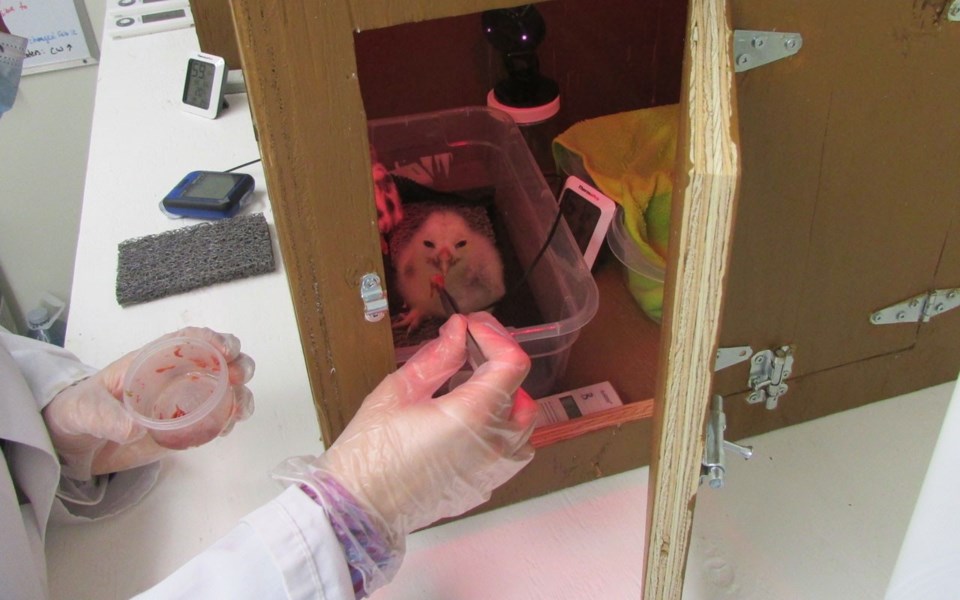
Once bonded, an owl pair will hopefully copulate in the spring: the male jumps on the female, she raises her tail, there's a lot of wing flapping, and they basically bounce off each other. "It's called a cloacal kiss," says McCulligh. The timing has to be perfect: mating has to happen just as an egg developing inside the female is about to form a shell. A female spotted owl will typically lay two eggs in March—in the centre, they steal the eggs so the mother is tricked into thinking hers have been eaten or lost, so then she will lay another two in April. Usually only about one in four eggs is fertilized. And then only about a quarter of those will make it past the first days of development and actually hatch.
Needless to say, those odds are not good: 2019 already holds the record for most chicks born in a season (the previous annual record was just two). McCulligh doesn't know if the statistics are similar in the wild. "There's a reason they're endangered. Some species are just challenging to breed," she sighs. They keep playing around with their owls' diet and other factors trying to bump up their fertility. Since 2011, the team has taken to artificially incubating the eggs that are laid, to raise the odds of chick survival.
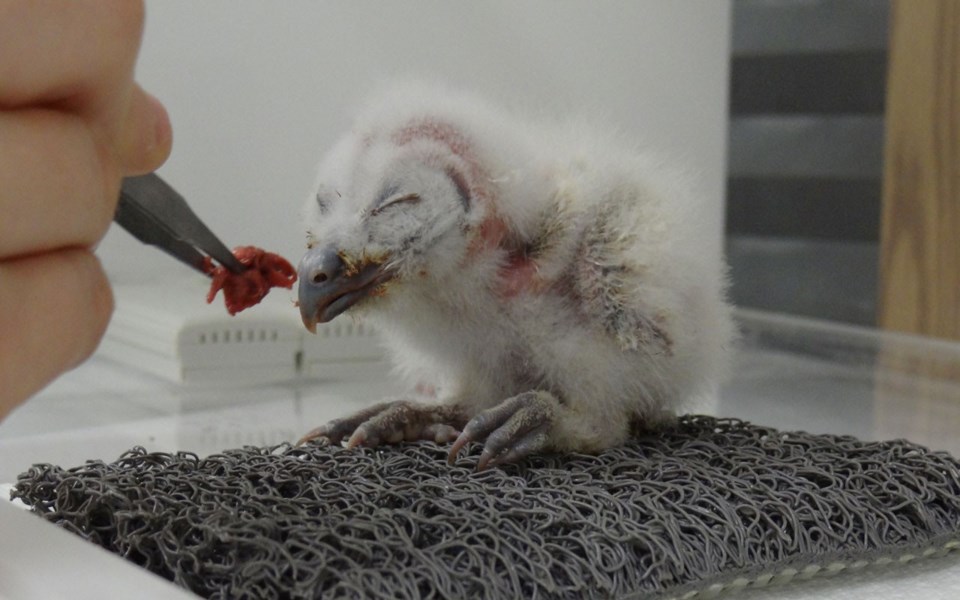
After an egg is laid, the team waits until the mother goes to relieve herself, and then they open a little secret door in the back of the nest and steal it, replacing it with a robotic decoy that collects data on things like temperature and humidity. "They don't get mad. I don't think they notice," says West. The real egg goes into an incubator, where they watch to see for any signs of life, says McCulligh.
Raising an egg can be tricky business. The liquid inside the egg has to evaporate to make room for the growing chick, but not so quickly that it dries out. The team has to keep a constant eye on the eggs' weights, and twiddle the humidity and temperature to suit, in four microwave-sized incubators. A host of sensors and alarms are deployed in case anything fails. "We have equipment to back up the back-up equipment," McCulligh laughs. The three staff members, who all live about 45 minutes away, get calls at all hours of the day or night to come in and fix the air conditioning, heaters, humidity controls, etc. At least once, they have had to glue a cracked egg back together.
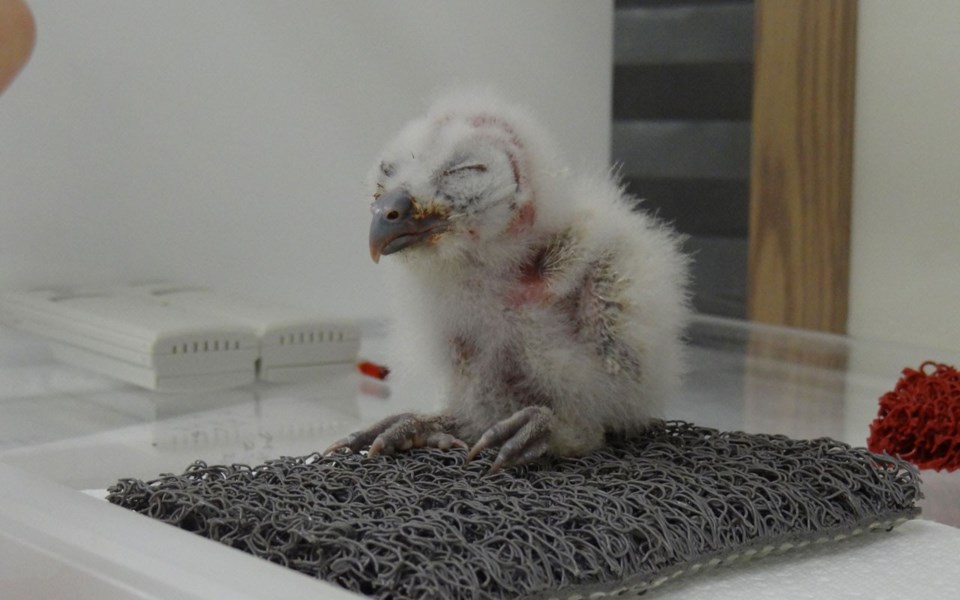
The team runs a parallel program for breeding barred owls, which runs about a month in advance of the spotted owl program. That lets them work out any bugs in the equipment, and train up new interns with a non-endangered species and non-critical eggs. "Can you imagine being in your 20s, in your first real job, and being handed an endangered animal?" McCulligh asks, shaking her head. "They get to practice. It's a really good opportunity for us to work out any kinks."
After 32 days, a spotted owl egg will start to hatch, and the team launches into 24-hour care: in early April, one of the three staff, or a volunteer, is there 24-7. The egg hatching is a performance. Chickens take about 20 minutes, but spotted owls take 80 hours or more (with other owl species, breeding programs intervene after 70 hours; this team learned quickly that spotted owls need more time). A newborn owlet is tiny and helpless. "They look like mouldy fruit or raw chicken," says McCulligh. Their eyes are sealed closed. They can't hold up their heads.
The team keeps hold of the newborns for 10 days, making sure they don't get an infection and are gaining weight. They don't want the owlets to think that the biologists are their mothers, so they don't talk in the baby room. "It's dead silent, or we play bird calls. They think they're in the forest," says McCulligh. Sometimes they give them little owl stuffies or sponges to cuddle up with. If they get sick, like Dante did, they have to experiment with different antibiotics, feeling their way to a cure with very little information to go on. Then they wait until mom goes off to relieve herself again, and sneak the chicks back into the nest.
Fortunately, spotted owls will rear just about anything. "The one easy thing about raising spotted owls is they're good, instinctive parents," says McCulligh. You can give them their own chicks, or another owl's, at any age, at any time of year, and they will usually take to feeding them. To be fair, it's a relatively brief parental commitment: the owls fledge at about three weeks, and are independent after a few months.
The team gives each chick a letter of the alphabet based on the order the eggs were laid; only when they're much older can they tell, from blood tests, whether an owl is male or female, and they then pick a name.
McCulligh talks about each owl with affection. Oregon, for instance, was dramatically rescued from his nest in 2013 after his father died. Zalea fell out of a tree before fledging and happened to be found by Ministry of Forests field staff, which brought her in to safety in 2017. She was raised by Amore and Sedin, a newly-bonded pair who hadn't had a chick yet but didn't blink when suddenly granted a three-week-old foster child. When the elderly Shakkai laid her last fertilized egg in 2014, the shell was too thin; the team jacked up the humidity in the incubator to 90 per cent and saved chick Jay's life. Jay is now all grown up: he and partner Bella produced one of this year's chicks.
One egg was laid on McCulligh's birthday when she first started as an intern in 2013. "I spent my entire birthday out in the rain waiting for her mom to get off the egg so we could take it," she remembers. "All the owls have their own special story, but she's mine ... She's my firstborn." They named her Skalula, the Salish word for "owl."
For McCulligh, this clearly isn't just a job, but a labour of love. "I've worked here since I was 23. It was my first real job out of university," she says. "It has been six years now. These are my kids."
As for Shakkai, at 25 years old this year, she was too old to be a mom again. McCulligh and West had to make the hard decision to pull her away from her younger husband, Einstein, to give him a chance to sire children with a younger mate (he's with Zalea now; they took to each other right away and produced one of this year's chicks). "It's very emotional for us," says McCulligh. Shakkai sadly passed away in April from cancer.
Back in October 2018, McCulligh and West rolled into Pemberton with a travelling slideshow about their owls. About a dozen keenly interested locals turned up, including myself and my two kids (a rambunctious four-year-old and a curious six-year-old, both predisposed to be scientists-in-training). There were posters, and coffee and fruit, and candy for the kids in the run-up to Halloween. McCulligh and West fielded questions before their slideshow. It was a big trip for the biologist duo. Though the program had been going on for more than a decade at that point, it had been very hush-hush for years, West tells me. No one wanted to draw attention to the few remaining spotted owls in the wild. "This is our first time out of the Lower Mainland," West says, her eyes a little wide.
They came to Pemberton for a reason: the area has the best remaining spotted owl habitat, says McCulligh. This is where they plan to reintroduce them, making it important for the team to get to know the area and the mood of its inhabitants.
My daughter and her friend dress up in little lab coats to "feed" stuffie versions of owls. "We'll have to clean them," the staff says; these are the actual stuffies used as surrogate siblings for the newborn owls.
While large swaths of forest remain in the Pemberton area, it's hardly undisturbed by logging, power lines and hydroelectric projects, all of which threaten to fragment spotted owl habitat. Right now, there are no known spotted owls in the Sea to Sky. Biologist Jared Hobbs, who used to work for the province and is now an independent contractor, says there are just three left in B.C., with no breeding pairs currently.
In 1986, spotted owls were assessed as endangered by the Committee on the Status of Endangered Wildlife in Canada; 10 years later, it received a federal listing under the Species at Risk Act. In 2004, a coalition of environmental groups launched a legal case through the Sierra Legal Defence Fund (now called Ecojustice) seeking an emergency order to protect the owls under that act. In 2006, the B.C. government released a spotted owl recovery strategy, and so the case was withdrawn while waiting to see what actions the province took.
So far, the groups have not been appeased. Problems remain, they say, with plans to conserve spotted owl habitat. The government plan led to $3.4 million of funding over five years, says Hobbs, but that was focused on the breeding program (which now runs at $300,000 a year) and efforts to cull barred owls in selected spots (Hobbs says that 189 barred owls have been removed, and 51 shot). In general, B.C. has not developed legislation to protect any of its 1,807 species at risk, according to a letter recently signed by more than a dozen academics and published in The Narwhal.
Officially, the B.C. government is managing more than 300,000 ha. for spotted owl recovery; according to a 2015 report, more than 7,000 ha. of that lies around Whistler. But, Hobbs notes, while that land is "capable" of supporting spotted owls sometime in the future, not all of it is currently suitable habitat—in some regions the trees are currently too young to provide good nesting sites. "Meanwhile, suitable territory outside managed territory is being ignored," he adds. Plus, some logging is allowed even in managed regions. Although a very small area around known nesting sites is protected (about 500 metres), industry is under no obligation to look for nesting sites, notes Ecojustice lawyer Kegan Pepper-Smith. According to non-profit the Wilderness Committee, a logging company felled trees about a kilometre away from the nest of a breeding pair of spotted owls living in Enterprise Creek, near Lillooet, in both 2004 and 2010.
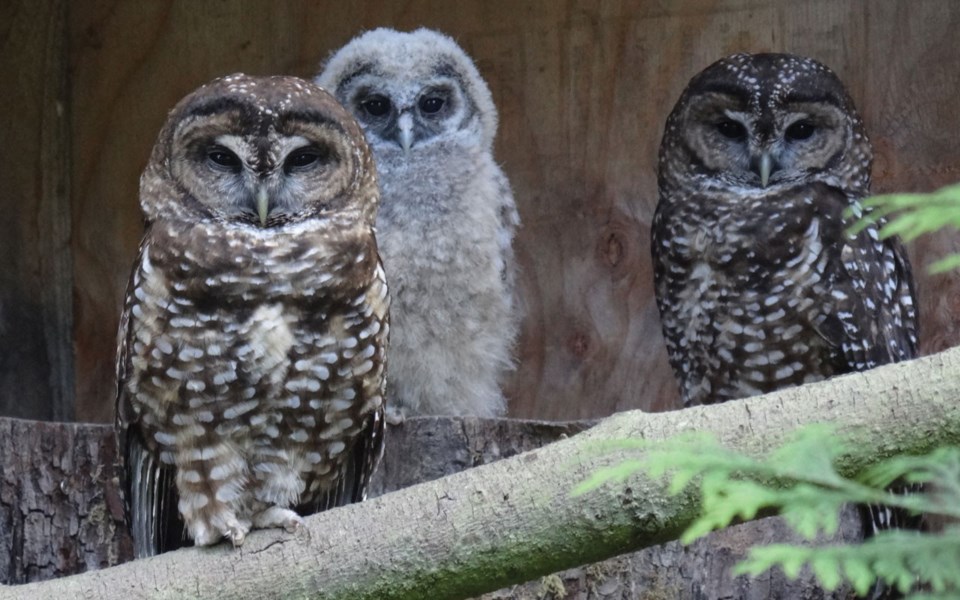
Hobbs is reticent to say where in the wild the three spotted owls are currently living, to help guard them. They all live within managed forest areas, he notes, although there is a proposal that is currently on hold for cut blocks in one of the owl's territories, Hobbs says.
"How can you expect to recover a species when you're not affording it protected habitat? Its disingenuous," says Hobbs. "If you don't address habitat you can't fix anything." On Wednesday, May 8, Ecojustice and the Wilderness Committee sent a letter to the federal government demanding action on the spotted owls after "decades of mismanagement by the provincial government," according to their press release. "B.C. can breed as many owls as it likes, if they don't also protect the Spotted Owl's old-growth habitat, the only way the owls will survive is in cages," says Pepper-Smith in the release. "Time is running out."
Given how things stand today, the breeding program is undoubtedly a vital part of the solution. "For a population in such dire straits, captive breeding is a logical step," says Hobbs. It's going slower than expected (Hobbs notes that for the nine born in captivity as of January 2019, they had also removed nine from the wild; it's taking a while to arrive at a net gain of owls). But others might say that's a good thing if it provides time for activists to help boost habitat preservation.
Meanwhile McCulligh is simply focused on her babies, and making as many healthy new owls as they can. "I'm hopeful for five babies this year," she said wistfully back before this year's eggs were laid. "Don't want to jinx it, though."
With three hatched already, and the season not yet over, they're off to a good start.



